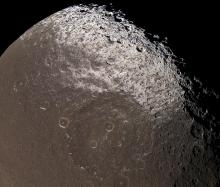Listen to today's episode of StarDate on the web the same day it airs in high-quality streaming audio without any extra ads or announcements. Choose a $8 one-month pass, or listen every day for a year for just $30.
You are here
Moon and Saturn
The Moon bowls past Saturn the next couple of nights. The planet looks like a bright star. It’s close to the lower left of the Moon tonight, and to the right of the Moon tomorrow night.
Saturn has a huge entourage of moons of its own. More than 50 have been plotted and named, and several others are awaiting final status — more than 60 in all.
The largest is Titan, a world with a dense, cold atmosphere and lakes filled with hydrocarbons. Titan contains more than 95 percent of the mass of Saturn’s entire system of moons and rings.
Most of the planet’s moons are nothing more than big boulders — chunks of rock no more than a couple of dozen miles across. These moons follow all kinds of orbits. Some of the orbits are quite lopsided, while others are tilted at different angles. Some orbits are even backwards — the moons move in the opposite direction from Saturn’s rotation.
These little moons appear to come in groups. The members of each group have something in common — some aspect of their orbits or composition. That suggests that the members of each group share a common origin. They may be remnants of a larger moon that was blasted apart by an impact, for example.
Such impacts need not be especially powerful. A recent study found that even low-speed collisions could split a moon apart or chip off big pieces. That could result in the odd shapes and sizes of many of the moons as well — giving Saturn a large and interesting collection of moons.
Script by Damond Benningfield





